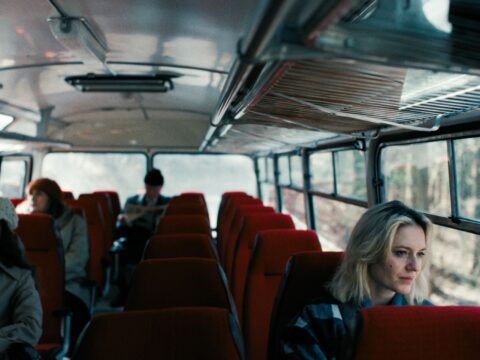Striking a balance between emotional resonance and artistic ambition is a difficult task for any filmmaker. If you go too hard for the heart, people will accuse you of being sentimental. Even worse: mawkish. On the flip side, dressing the story up in too much style can quickly overwhelm the narrative.
Austro-Slovak Tiger Competition entry Perla (Alexandra Makarová, 2025) is certainly well-made. It might carry the very definition of “handsomely mounted.” Yet it is this very technically gifted aesthetic that distracts from what, at its core, should be a deeply harrowing tale. One doesn’t so much bemoan the horrors of communism than wonder where they got all those excellent light fixtures from.
Entering the 4:3 frame, walking through a doorway with a riot of blonde hair, a playful smile and no money to her name: the eponymous Perla (Rebeka Poláková). She lives in Vienna in 1981 with her daughter Julia (Carmen Diego), an aspiring pianist. She may not be wealthy, but she’s happy, with an upcoming exhibition in New York, a new love interest in the form of Josef (Simon Schwarz) and the liberating sound of Bronski Beat in the air. Then one day she gets a call from Czechoslovakia: Julia’s father Andrej (Noel Czuczor) is out of prison and is dying of cancer.
Having barely survived the horrors of communism herself, returning to the old country could spell immense danger for Perla. Still, due to a mixture of survivor’s guilt, a complicated mixture of feelings towards her old lover and good old-fashioned nostalgia for her homeland, she returns, to fiendish knotty results.
There’s a lot to chew on here vis-à-vis the intersection of communist oppression and patriarchal thinking, and how even in so-called liberated Vienna, men still want to tell women the right way to live. Nonetheless, I found it hard to concentrate and become invested into the film due to its constantly studied manner, bringing to mind everything from Munich-era (2005) Spielberg to Bergman’s Silence trilogy (1961-1963) to Petzold’s more classical works.
When reviewing Underworld (Len Wiseman, 2003), Todd McCarthy famously quipped, “there may be more openings and closings of doors in this picture than in the entire oeuvre of Ernst Lubitsch.” Likewise, few films have filmed through more doors than Perla, which constantly clutters the images with things: doorframes, the sides of chairs, champagne glasses, the backs of people’s shoulders.
Sometimes this technique works, such as the first meetup between Perla and Josef, with him catching her eye at the end of the bustling room, the camera following him as he moves past the crowd of people, until its finally the two of them meeting for the first time. It also works as Perla meets Andrej after ten years, with a slow zoom passing a kiosk as they meet in the park. But at other times, such as a couple of crucial character moments caught from an elevated height in medium-distance, or an intimate scene told via a perfectly placed mirror, it feels superflous. The greatest asset any actor has is their face, but Makarová, alongside cinematographer Georg Weiss, save the all-important close-up for the end. By then, it’s already too late.
Redmond is the editor-in-chief of Journey Into Cinema.

